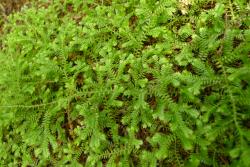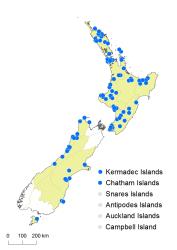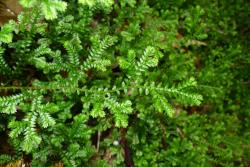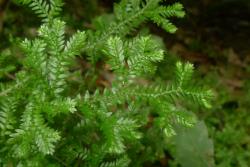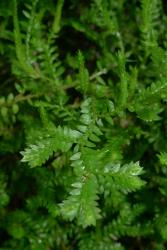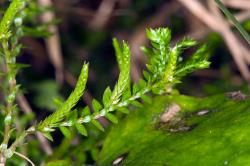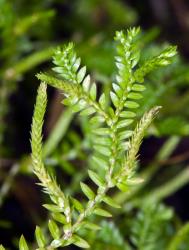- Taxon
- Weed
- Gallery
- ≡ Lycopodium kraussianum Kunze, Linnaea 18: 114 (1844)
Terrestrial plants. Stems far-creeping, up to 420 mm long, irregularly and widely branched, branches not overlapping except at the stem apices, forming a loose, prostrate mat with apices of ultimate branches upturned; stems yellow-brown proximally, green distally; longest branches 25–130 mm long. Roots arising from axils of branches, occurring throughout the length of the stems. Leaves widely spaced on creeping stems, but imbricate on ultimate branches, pale green proximally, dark green at branch apices, minutely toothed on margins, bases cordate, of two sizes; those in the two lateral rows larger, 2.5–4 mm long, 1.0–2.3 mm wide, spreading, ovate or rarely elliptic, apices acute; those in the two upper rows smaller, 1.5–2.5 mm long, 0.5–1.3 mm wide, closely appressed to stem, ovate, acute to acuminate. Strobili lateral on ultimate branches, sessile, 4–15 mm long, 1.4–2.5 mm diameter, round in cross-section, inconspicuous. Sporophylls similar to leaves of upper rows but smaller and more acuminate, 1.0–1.6 mm long, monomorphic, arranged in four ranks. Megaspores cream to white, with surface ridges forming 5–6-sided polygons. Microspores cream to buff, with long spines projecting from the surface.
Selaginella kraussiana is now a widespread weed in New Zealand and easily the most common of the three introduced species. Its prostrate and irregularly branching habit with roots produced throughout the length of the stem readily distinguish it from S. moellendorffii, which produces erect, aerial, frond-like branching systems with roots at the base. Selaginella kraussiana is similar to S. martensii but the latter has a suberect habit with ultimate branches upturned in the distal half, and roots produced only in the proximal half. Branches are more widely spaced in S. kraussiana and rarely overlapping, whereas in S. martensii they regularly overlap. The leaf margins are minutely toothed in S. kraussiana but finely ciliate in S. martensii. The microspores of S. kraussiana have distinctive surface spines and the megaspores have irregular hexagonal ridges (Large & Braggins 1991, figs 49–57).
North Island: Northland, Auckland, Volcanic Plateau, Gisborne, Taranaki, Southern North Island.
South Island: Western Nelson, Westland, Canterbury, Otago.
Kermadec Islands, Chatham Islands, Stewart Island.
Altitudinal range: 0–640 m.
Selaginella kraussiana occurs in lowland and montane areas of the North Island from Karikari Peninsula to Wellington but is apparently scarce in the central North Island. It extends from near sea level, reaching over 450 m at Matawai and in north Taranaki. In the South Island it occurs in coastal and lowland regions from north-west Nelson south to Fox Glacier, and on the east coast from Christchurch to Dunedin, reaching 640 m near Sewell Peak, Greymouth. It also occurs on Stewart Island, the Chatham Islands, and on the Kermadec Islands, from where it has been eradicated. It has been seen in Fiordland (Alex Fergus, pers. comm., June 2016), but not yet collected from there, and hence not included on the distribution map.
Occurs naturally in tropical and southern Africa, but is now naturalised in central and western Europe (Crouch et al. 2011), south-eastern USA (Valdespino 1993), South America (Zuloaga et al. 2008), Australia (Jermy & Holmes 1998), Hawai‘i (Palmer 2003), and probably elsewhere.
Selaginella kraussiana grows on damp banks, tracksides, stream banks, river terraces, forest margins, and in generally shady and damp places under kauri, podocarp, broadleaved, kānuka forest and introduced trees, and in scrub or amongst introduced grasses. It also occurs in parks, gardens, shade houses, cemeteries, picnic areas and lawns. It spreads readily from vegetative fragments.
Cheeseman (1919, p. 92, as Selaginella denticulata). Voucher AK 110931, Pākaraka, Bay of Islands. Cheeseman noted that it had been known for many years as a garden escape at Pākaraka, and had lately appeared in great abundance on the banks of several swampy creeks in the neighbourhood. He also remarked that it was known in several localities near Wellington, and anticipated that it would spread further.



